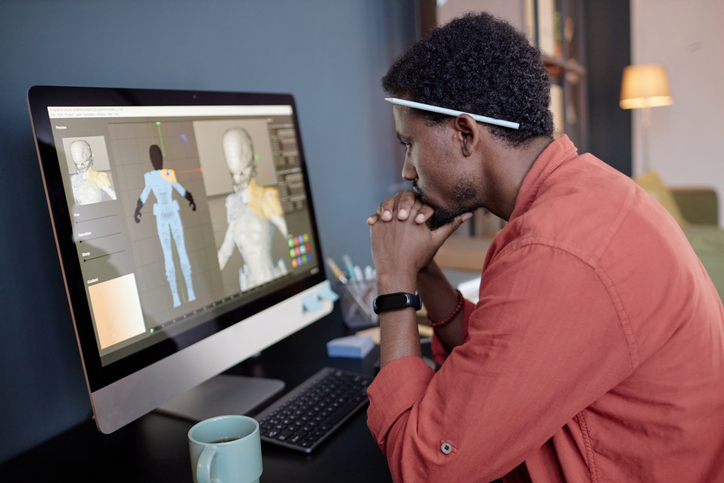The world of architecture is constantly evolving, blending creativity with functionality to shape the spaces we live, work, and play in. But behind every well-designed structure stands an expert who brings visionary ideas to life, an Architectural Designer. If you’ve ever been fascinated by buildings, drawn to the idea of designing functional yet artistic spaces, or intrigued by the latest architectural software, this career path might be for you.
This blog explores what an Architectural Designer does, the skills required to excel in the field, and how VCAD’s Architectural Design Technology Diploma Program can set you on the path to success.
What is an Architectural Designer?
An Architectural Designer is a professional who specializes in the design and development of buildings and spaces. Unlike registered architects, who require formal accreditation and licensing, Architectural Designers focus primarily on design, drafting, and project planning. They play a critical role in the construction industry by turning ideas into blueprints, ensuring that buildings are both aesthetically pleasing and structurally sound.
Whether it’s a residential home, commercial building, or urban landscape, an Architectural Designer is responsible for creating designs that are functional, efficient, and compliant with building regulations. With the increasing demand for sustainable and technologically advanced buildings, the need for skilled Architectural Designers is higher than ever.
Skills Required for Architectural Designers
To succeed as an Architectural Designer, a balance of technical proficiency and creative vision is essential. The ability to understand blueprints and construction plans, work with cutting-edge design software, and navigate the complexities of building regulations is just as important as the ability to think innovatively, solve problems, and communicate ideas effectively. Let’s explore the most crucial hard and soft skills that define a successful Architectural Designer.
Hard Skills for Architectural Designers
Architectural drawing and construction plans
A deep understanding of architectural drawing and construction plans is at the heart of this profession. Architectural Designers must be able to read, interpret, and create technical drawings that detail every aspect of a building’s structure, layout, and systems. These drawings serve as a blueprint for construction teams, ensuring that designs are implemented accurately and efficiently. The ability to translate design concepts into precise, standardized documentation is fundamental to success in the field, which is why VCAD’s program places a strong emphasis on teaching students how to create detailed construction drawings using industry-standard techniques.
Design software
Proficiency in design software is another indispensable skill. In today’s digital-driven industry, Architectural Designers must be adept at using tools such as AutoCAD, Revit, and SketchUp for digital modeling and drafting. These programs allow designers to create, modify, and refine their designs with precision, providing detailed plans that guide every stage of a project. Mastery of these tools not only increases efficiency but also enhances the ability to experiment with different design concepts and visualize structures in 3D. VCAD’s Architectural Design Technology courses focus on real-world applications of these software tools, ensuring that students develop practical, hands-on expertise that will benefit them in their careers.
Building code compliance and regulations
A comprehensive knowledge of building code compliance and regulations is also essential. Every architectural design must meet specific legal, safety, and environmental requirements. Designers must stay up to date with zoning laws, construction codes, and accessibility standards to ensure that their projects comply with industry regulations. Navigating these guidelines can be complex, but it is a crucial part of ensuring that structures are safe, functional, and legally sound. VCAD incorporates lessons on building codes and compliance into its curriculum, preparing students to meet industry standards with confidence.
3D digital renderings and visualizations
The ability to create 3D digital renderings and visualizations is becoming increasingly important in the industry. These visualizations help clients, stakeholders, and construction teams better understand the intended design, allowing for clearer communication and more informed decision-making. Digital modeling enables designers to explore different aesthetic and functional options, adjust as needed, and bring their ideas to life before construction begins. VCAD provides hands-on training in 3D rendering, helping students build strong portfolios that showcase their technical and artistic abilities.
Material selection and sustainability practices
In addition to technical knowledge, material selection and sustainability practices are critical aspects of modern architectural design. Designers must have a thorough understanding of various building materials, their properties, durability, and environmental impact. Choosing the right materials not only affects the aesthetic appeal of a structure but also influences its energy efficiency, sustainability, and long-term maintenance. Sustainable design has become a significant focus in the field, with increasing emphasis on eco-friendly building practices, energy-efficient technologies, and reducing carbon footprints. VCAD integrates environmental architectural design principles into its program, ensuring that students are well-versed in sustainable building strategies.
Soft Skills for Architectural Designers
Beyond technical expertise, Architectural Designers must possess a range of soft skills to thrive in this field.
Creativity and innovation
Creativity and innovation are essential in architectural design, requiring designers to balance functionality with aesthetics. They must push creative boundaries while meeting client needs and industry standards. VCAD encourages students to explore innovative approaches through a design-thinking mindset that enhances creative potential.
Problem-solving and critical thinking
Problem-solving and critical thinking are crucial for addressing design constraints, budget limitations, and structural considerations. Designers must anticipate challenges and develop solutions that align with project goals. VCAD’s hands-on projects prepare students for real-world problem-solving, equipping them with the adaptability required in the industry.
Communication and collaboration
Communication and collaboration are key for working with clients, engineers, and contractors. Architectural Designers must present ideas effectively and ensure alignment among all stakeholders. Strong presentation and interpersonal skills help in translating technical details into understandable concepts. VCAD supports students in developing these essential skills through interactive learning experiences.
Project and time management
Project management and time management skills allow designers to juggle multiple projects while meeting deadlines. Managing workflows, prioritizing tasks, and ensuring timely project completion require excellent organizational abilities. VCAD integrates project management techniques into its curriculum, preparing graduates to handle complex projects efficiently.
By mastering both technical and soft skills, aspiring Architectural Designers can establish a strong foundation for success. VCAD’s Architectural Design Technology Diploma Program provides a comprehensive education, blending hands-on experience with industry-standard tools to prepare students for a dynamic career in architectural design.
What Does an Architectural Designer Do?
Architectural Designers play a crucial role in shaping the built environment, guiding projects from concept to completion. Their work blends creativity with technical expertise, ensuring that structures are functional, aesthetically pleasing, and compliant with regulations. Let’s explore their key responsibilities.
1. Concept Development & Design Planning
Every architectural project begins with a vision. Architectural Designers meet with clients to understand their needs, preferences, and budget. They sketch initial design ideas, create multiple conceptual models, and research site conditions, zoning laws, and environmental factors to ensure feasibility. This phase sets the foundation for a successful project, balancing client aspirations with practical constraints.
2. Creating Detailed Architectural Drawings
Once a concept is approved, designers translate ideas into blueprints, technical drawings, and 3D models using software like AutoCAD, Revit, and SketchUp. These plans guide the construction process, ensuring that the design is both structurally sound and visually compelling. Architectural Designers work closely with engineers to refine layouts, considering factors like load-bearing structures, material selection, and legal requirements.
3. Collaborating with Industry Professionals
Architectural Designers work alongside architects, engineers, interior designers, and contractors to bring projects to life. They ensure that structural elements, building materials, and design aesthetics align with the overall vision. Communication and teamwork are essential as they coordinate with construction teams, address challenges, and make design adjustments when necessary.
4. Ensuring Code Compliance & Sustainability
Architectural Designers must stay informed about building codes, zoning laws, and safety regulations to ensure all designs meet legal requirements. Sustainability is also a growing priority, with designers incorporating energy-efficient systems, eco-friendly materials, and green building techniques into their work. By prioritizing environmental responsibility, they help create structures that are both functional and sustainable.
5. Presenting Designs & Managing Projects
Beyond design, Architectural Designers are responsible for presenting their work to clients and stakeholders. They create compelling 3D renderings and visualizations, helping clients visualize the final project. Effective time and project management skills are crucial, as designers must oversee deadlines, budgets, and construction progress to ensure projects stay on track.
For those passionate about architecture and design, VCAD’s Architectural Design Technology Diploma Program provides hands-on training, industry-standard software skills, and expert guidance. Whether you dream of designing homes, commercial spaces, or urban landscapes, this program equips you with the tools to turn ideas into reality.
VCAD’s Architectural Design Technology Program
If you’re passionate about architectural design and eager to develop both technical and creative skills, VCAD’s Architectural Design Technology Diploma Program is the ideal way to start your journey. This program provides a flexible, hands-on learning experience, equipping students with industry-relevant skills to succeed in the dynamic world of architecture.
Why Choose VCAD?
✔ Fully Online Learning
Study from anywhere at your own pace while receiving expert guidance from experienced instructors. Whether you're balancing work, family, or other commitments, VCAD’s online format allows you to customize your learning experience without compromising on quality.
✔ Master Industry-Standard Software
Gain hands-on training with essential architectural tools like AutoCAD, Revit, and SketchUp. These programs are widely used in the industry and are crucial for creating detailed blueprints, 3D models, and construction plans.
✔ Build a Professional Portfolio
Throughout the program, students work on real-world design projects, refining their skills in architectural drawing, construction documentation, and 3D visualization. By graduation, you’ll have a comprehensive portfolio that showcases your abilities to potential employers.
✔ Flexible Learning Options
VCAD understands that every student has different needs, so the program offers both online and on campus options to fit your schedule. Whether you’re pursuing a new career or upgrading your skills, you’ll have the flexibility to learn at your own pace.
✔ Recognized Program
VCAD’s Architectural Design Technology Diploma is certified by the Private Training Institutions Regulatory Unit (PTIRU) under the Ministry of Post-Secondary Education and Future Skills. This ensures that you receive a quality education that meets industry standards.
With VCAD’s industry-focused curriculum, expert instructors, and hands-on projects, you’ll gain the skills and confidence to pursue a rewarding career in architectural design. Whether you envision designing residential, commercial, or urban spaces, this program provides the tools to bring your ideas to life.
Ready to take the next step? Start your journey in architectural design today with VCAD!
Final Thoughts
Architectural Designers play a critical role in shaping the world around us. From designing sustainable homes to creating stunning commercial spaces, their work blends artistic creativity with technical precision.
If you’re ready to turn your passion into a profession, VCAD’s Architectural Design Technology Diploma Program provides the skills, software training, and real-world experience to launch your career.
Start your journey today and become the next visionary Architectural Designer!
Interested in learning more? Contact VCAD today and take the first step toward your dream career!














